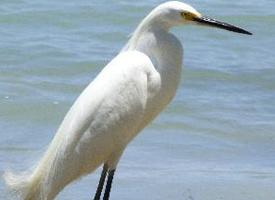
Súlyok és méretek
| Hossz | 50-tól 60-ig cm |
|---|---|
| Súly | 450-tól 600-ig g |
| Szárnyfesztávolság | 95-tól 100-ig cm |
Veszélyeztetettség
| Rettenthetetlen |
Állatleírás
The Little Egret (Egretta garzetta) is a species of small heron renowned for its elegant appearance and delicate movements. It is a member of the family Ardeidae, which includes other herons, egrets, and bitterns. This bird is widely distributed, with populations found in parts of Europe, Asia, Africa, and Australia. It has adapted to a wide range of wetland habitats, including marshes, riverbanks, lakesides, and estuaries, making it a common sight in both freshwater and coastal environments.Characterized by its slender build, the Little Egret stands at a height of about 55-65 cm (22-26 inches) with a wingspan ranging from 88 to 106 cm (35-42 inches). It weighs approximately 350 to 550 grams (0.77-1.21 pounds). The most striking feature of this bird is its pure white plumage, which gleams in the sunlight and provides a stark contrast against the various backdrops of its natural habitat. During the breeding season, it sports long, delicate nuptial plumes on the back of its head, neck, and back, which were once highly prized and nearly led to the bird's extinction due to overhunting in the 19th century.
The Little Egret has a black bill, slender and pointed, ideal for catching its prey. Its legs are long and black, with strikingly yellow feet, which it uses skillfully to stir up and catch fish, crustaceans, amphibians, and insects in shallow waters. The bird's face is adorned with lores that are greenish-yellow, becoming brighter during the breeding season.
One of the most enchanting behaviors of the Little Egret is its hunting technique. It can often be seen walking slowly through shallow waters, suddenly darting forward to spear a fish with its bill, or standing still with open wings to shade part of the water, enticing fish into the shaded area before catching them.
Breeding typically occurs in spring and summer. The Little Egret nests in colonies, often with other heron species. Nests are constructed from twigs and are usually situated in trees or bushes near water. Females lay between three to five pale blue eggs, which both parents incubate for about 21 to 25 days. The chicks are altricial, meaning they are born blind and featherless, and are dependent on their parents for food and protection for several weeks until they are ready to fledge.
The Little Egret migrates seasonally in some parts of its range, moving to warmer areas during the winter. However, in its more temperate and tropical habitats, it may be a resident year-round.
Conservation efforts have helped the Little Egret's populations recover from historical declines. It is now listed as Least Concern on the IUCN Red List, reflecting its wide distribution and stable population size. However, the species remains vulnerable to habitat destruction and pollution, emphasizing the importance of continued conservation efforts to ensure the survival of this elegant bird.
Hasonló állatok
Új állatfotók
Top 10 állat
- Dolphin gull (Leucophaeus scoresbii)
- Japanese macaque (Macaca fuscata)
- Stone loach (Barbatula barbatula)
- Russian tortoise (Testudo horsfieldii)
- Galápagos tortoise (Geochelone nigra complex)
- Greek tortoise (Testudo graeca)
- Diana monkey (Cercopithecus diana)
- Common flying dragon (Draco volans)
- Moustached guenon (Cercopithecus cephus)
- Galápagos penguin (Spheniscus mendiculus)


